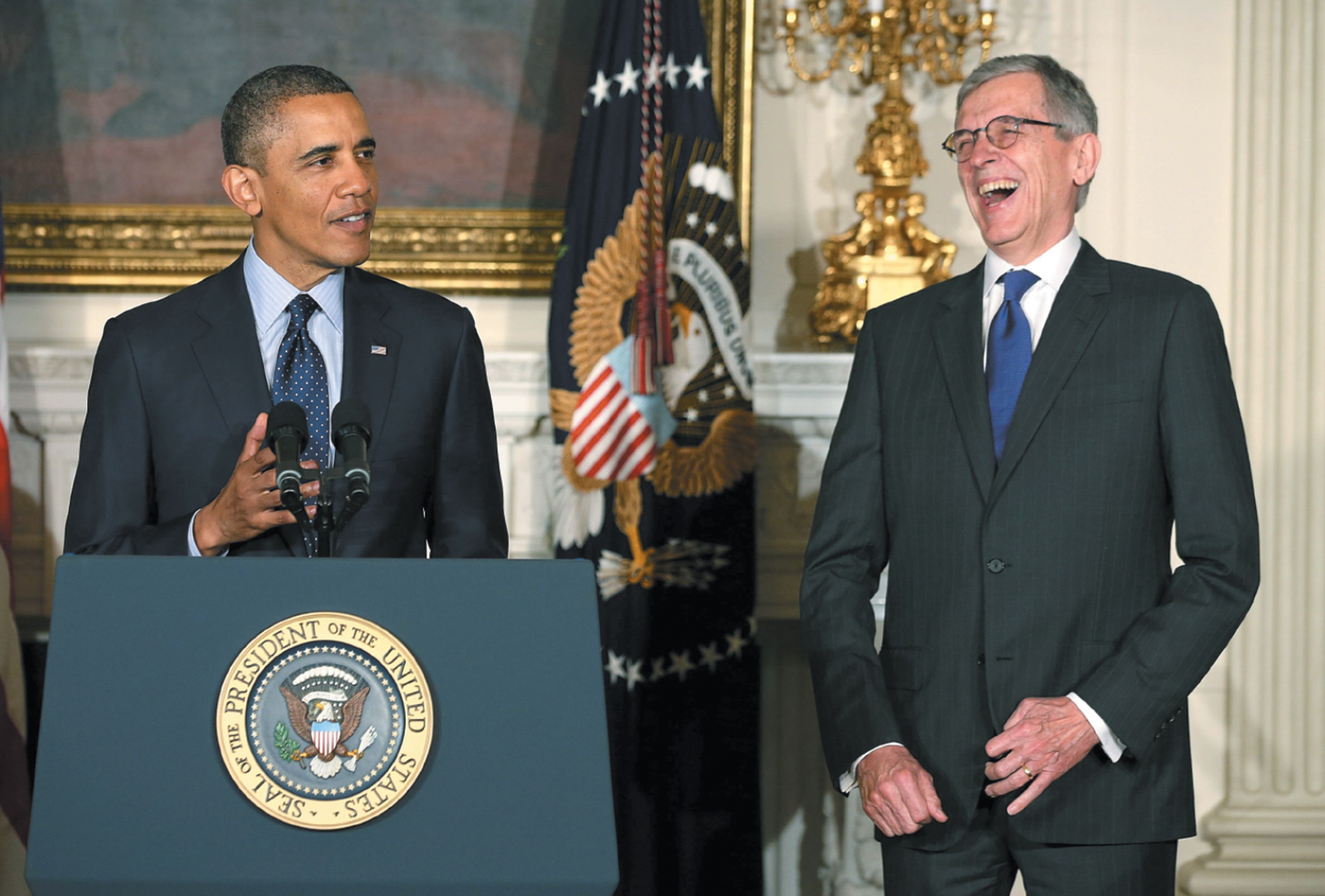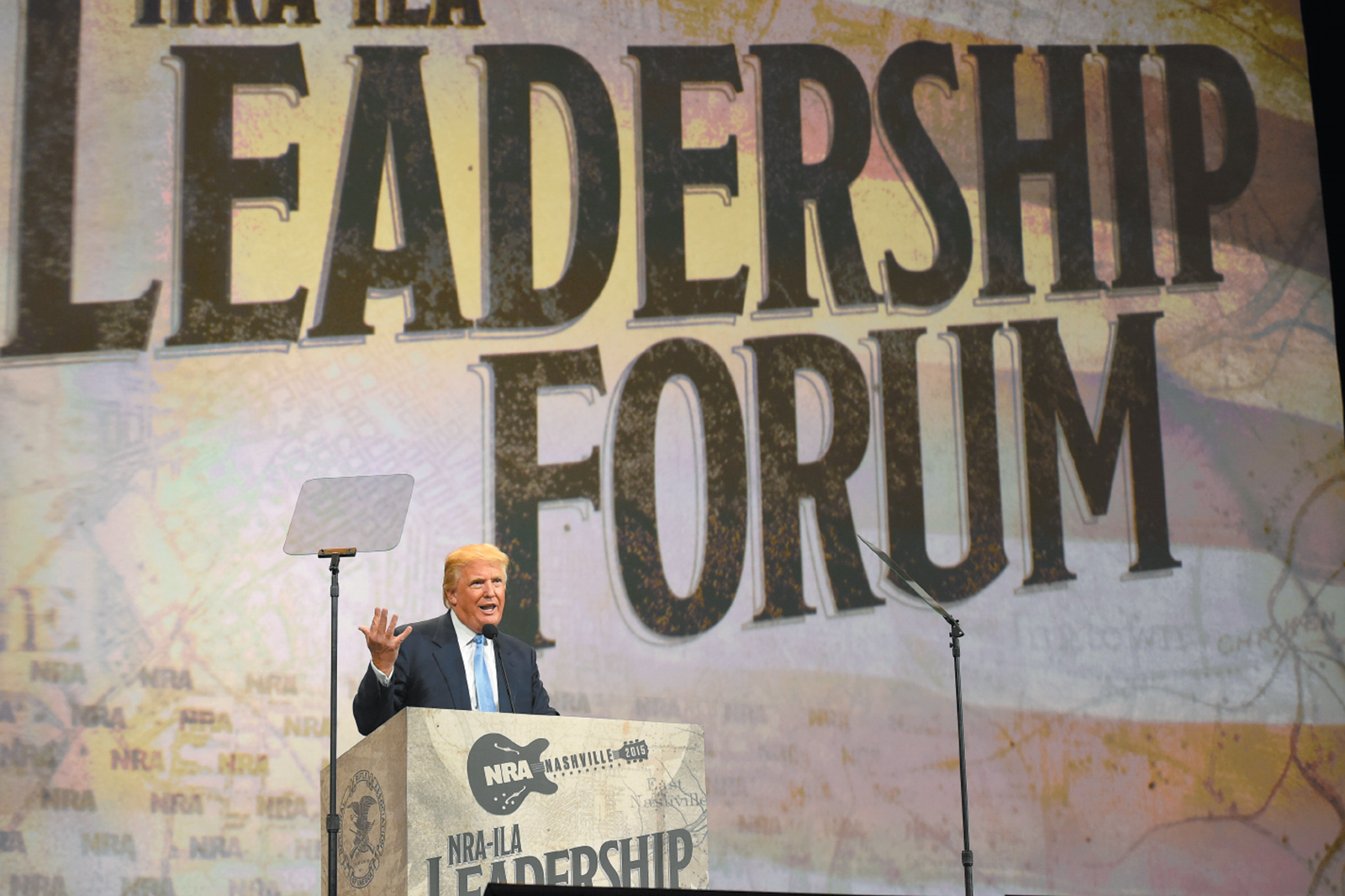On President Obama’s first day in office in 2009, he issued an executive order to close “the revolving door” between government and the private sector by restricting the hiring of any registered lobbyists for positions in his administration. But Obama himself eventually hired at least seventy lobbyists, many of whom then returned to lobbying after a stint in his administration. So much for Obama’s campaign pledge that he would “tell the corporate lobbyists that their days of setting the agenda in Washington are over.” The executive order has since been dropped, and the number of business lobbyists in Washington has continued rising rapidly.
Taking jabs at the profession remains a popular sport, even among Republicans. Donald Trump claimed at one of the Republican debates this fall that he would not talk to lobbyists once elected. Jeb Bush said that he would not let any more into Washington’s halls of power. The question remains: How much influence on Washington’s agenda do business lobbyists have?
A book titled The Business of America Is Lobbying by a highly regarded Washington watchdog, Lee Drutman, is therefore welcome, especially during a new presidential season. It takes some wading through Drutman’s disorganized prose and his sometimes ambivalent feelings about lobbying to find his main messages. But there are two crucial points that are disturbing. The first is that business spends $34 on lobbying for every dollar spent by likely opponents such as labor unions and other interest groups.
The second point is, I think, Drutman’s most important. It may once have been adequate for lobbyists to provide business clients access to the right people. Today, however, they also must develop expertise on major political issues, so that they can provide policymakers with research, draft legislation, and pass on up-to-the-minute information. Lobbyists, not staffers, concludes Drutman, are now the major source of information for Congress and the executive branch on major legislative issues. In one survey, two thirds of congressional staffers said they depend on lobbyists for the information they need to make legislative decisions and pass bills. Thus lobbying grows because Congress, and often the executive branch, needs lobbyists.
To sum up Drutman’s main theme, there is a large imbalance of both lobbying money and expertise that enables lobbyists to influence much of the Washington agenda today. Drutman believes this influence must be trimmed, and he proposes a number of reforms to address the asymmetry of money and expertise—including a new public lobby—that I believe may be effective and will discuss below. But none of Drutman’s proposals has been discussed in the presidential campaigns thus far. The candidates are more content to sling insults than to take the power of lobbying seriously.
What Drutman does not address, however, is what we probably most expect him to. As he tells us with academic dryness, lobbyists have three major duties: to make contacts for their business clients, to develop expertise in the issues that will affect them, and to keep an ear to the ground to be sure their clients know what legislative and regulatory changes may affect them.
But he does not provide more than a few examples of how business lobbyists do the job of persuading policymakers to vote their way. We know that the representatives of business, given their money, can meet with more policymakers than other interest groups, but what happens when they do? We also know from Drutman that the amply financed staffs of lobbyists can provide policymakers a great deal of expertise, much of which may be biased toward business. But we are offered few examples of how that information is twisted to favor clients. We are given almost no examples of behind-the-scenes horse trading, arm twisting, or hints of campaign contributions in return for helpful legislation. Just how, for example, did the financial community, whose influence many policymakers such as Elizabeth Warren decry, weaken the Dodd-Frank reform proposals? We learn next to nothing firsthand about how a business may propose a new plant in a congressman’s district in exchange for a tax break, or threaten to move a plant to another state if one is canceled.
Most surprisingly, Drutman hardly addresses campaign contributions at all because, he notes, business spends about thirteen times as much on lobbying as it does on political action committees—hardly an adequate reason. Further, he notes, it is very hard to ascribe specific legislative victories to persistent meetings with lobbyists or the flow of white papers. Scholars, he writes, often can’t find “a consistent correlation between lobbying activity and lobbying success on any given issue.”
But there are some advantages in telling this story from a high, almost academic altitude, as Drutman does. He shows persuasively how big spending on lobbying has changed the legislative environment to favor rich corporations. As lobbying expenditures rise, the game of influence has become far more competitive, so any given business is required to spend more to gain access to lawmakers and to develop the best expertise on various issues. Drutman also notes that it is harder to change the status quo with new legislation because there are so many influential interests benefiting from existing law. The victor who favors change is often the business that spends most.
Advertisement
Over the years, business spending on lobbying has been aimed at changing the “intellectual environment.” The requirement is again to invest “considerable sums in saturating the ‘intellectual environment,’” writes Drutman, making it possible to overload “the minds of policymakers and their staff so that when the time comes to make a decision, certain argument and frames will come to mind quicker than others.” The lobbying firms, with their clients’ funding, underwrite think tanks that write research papers and Op-Ed pieces and participate in countless panel discussions. The number of think tanks tripled from one hundred to roughly three hundred between 1970 and 1996, most of them right-wing. These include conservative think tanks like the Heritage Foundation, the Business Roundtable, and the US Chamber of Commerce. There are far fewer liberal think tanks, an influential example being the center-left Center for American Progress. “Often, the intellectual environment is overwhelmingly on one side of the issue, but is sparse on the other side,” Drutman points out.
The point Drutman raises most clearly is to me the most dangerous. Business lobbyists are offering higher pay to more and more congressional staffers, thus depleting Congress of its best, most experienced analysts. Those who hold senior staff positions that bring them into constant contact with lawmakers are offered up to $300,000 a year and more, and typically lobbying firms offer double the pay of less experienced staffers. Thus, lobbyists are not so much pounding on the doors of congressional offices; staffers are welcoming them in.
Lobbyists, writes Drutman, are now deeply involved with developing and drafting of legislation. They also help staffers
develop the talking points and explanations for why the legislation makes sense, write speeches and letters in support of it, seek out co-sponsors and supporters both within and outside of government, and generally see a bill through from start to finish.
Some analysts term this a “lobbying subsidy” to Congress. Oddly, Drutman is not always alarmed at this influence. In a study he did with a colleague, for example, he found that Enron’s political e-mails made arguments on the merits, and that its great resource was “its monopoly of policy-relevant information.” He was on the staff of a senator and he writes that “this author’s personal experiences working in the Senate found that the majority of corporate lobbyists do know an incredible amount about their particular policy area, and are indeed very helpful as researchers and analysts.”
For all these affirmations, which are expressed by Drutman in somewhat disorganized ways, he remains highly concerned about the imbalance of spending and information in Washington today. He quotes Richard Hall and Alan Deardorff, authors of the 2006 paper “Lobbying as Legislative Subsidy”:
Legislators…work hard primarily on behalf of the interests that can afford the high costs, not only of organizing and making campaign contributions, but of paying professional lobbyists and financing the organizations that support them.
One example of how lobbyists actually write legislation involved a controversial rule to disallow banks from using depositors’ money to invest in derivatives. Financial reformers believe that such speculation shouldn’t be financed by savers’ deposits, which are insured by the Federal Deposit Insurance Corporation. In this case, Citibank rewrote almost all of two paragraphs of legislation that undermined the reform. Drutman provides too few such examples. But a number of academic studies conclude from specific cases that lobbying pays off financially. Several of the studies he cites briefly arrive at the following conclusions:
—The stocks of the firms that spent the most on lobbying as a percentage of their assets beat market averages substantially.
—The more firms lobby, the lower their tax rates.
—Lobbying has a positive effect on a firm’s return on equity compared to the market as a whole.
—Companies that lobby intensively are less likely to be detected for fraud than other companies.
—Companies with politically connected board members have higher stock market returns than others.
The largest lobbyists in America over the years 1981 to 2004 included AT&T, General Electric, Boeing, Lockheed, and General Motors. These and dozens of other giant corporations are members of the US Chamber of Commerce, which lobbies aggressively for big business. Alyssa Katz has taken on the chamber in her new book, The Influence Machine. Where Drutman remains scholarly and cautious, Katz attacks freely. She calls the chamber “the most fully realized political influence machine the nation has ever seen.” She introduces us to the kinds of tactics Drutman largely sidesteps, such as aggressive lawsuits against government regulation and expensive election campaign techniques, including what many would justifiably call deceptive television commercials. The chamber also lobbies Congress and supports think tanks that share its views, including on the danger of big government.
Advertisement
Among the chamber’s targets have been car safety rules, restraints on smoking, limitations on greenhouse gas emissions, a variety of regulations under the Dodd-Frank law, the Consumer Financial Protection Bureau, and the Obama health care plan. In each case the chamber employed lobbyists, held meetings, and used advertising in attempts to stop the regulation of business. It also took the lead in developing a business coalition to support candidates, just skirting the campaign laws, according to Katz. Its goal was to provide opposition to the labor unions.
The campaign to stop Congress from imposing a tax on cigarettes was among the chamber’s first major successes, writes Katz, and is among the most illustrative. In 1998, Tom Donohue, the head of the chamber, told a major donor, Philip Morris, that his “goal is simple—to build the biggest gorilla in this town—the most aggressive and vigorous business advocate our nation has ever seen.” Before the vote to apply a $1.10 tax on every package of cigarettes, sponsored by John McCain, the chamber spent $100,000 on television ads showing lobbyists coming out of clown cars to descend on Washington. In one of the ads a waitress asks, “Taxing people like me to pay millionaire trial lawyers? What’s next?”
The chamber sent letters to every senator and to grassroots organizations, warning that the tax would enrich trial lawyers at the expense of the poor and create a huge black market in cigarettes. Going further, the chamber threatened to include the vote in its influential How They Voted list, claiming that those who voted for it did not stand up for business. The Senate finally blocked the bill.
The chamber often wins. Among legislators it helped to defeat were South Dakota Senator Tom Daschle, former leader of the Senate Democrats in 2004, and three senators in 2014, giving control of the Senate to the Republicans. It also helped elect Scott Brown in 2010 to replace Massachusetts Senator Edward Kennedy after his death. Katz writes that the Brown victory made the chamber the “undisputed kingmaker of congressional campaigns.” But Elizabeth Warren, who first proposed the Consumer Financial Protection Bureau, which the chamber had vigorously fought in court, defeated Brown in the 2012 election despite the chamber’s efforts, and the bureau she advocated is still with us. American democracy is not completely subject to lobbying dollars. Sometimes we must be reminded of this, which Katz infrequently does.
Katz does not carefully assess what other factors may have gone into voting on an variety of bills. She is more of a muckraker than an objective journalist. Still, her stories about the chamber’s influence are revealing. “The Chamber of Commerce holds members of Congress in vulnerable seats hostage and terrorizes them with threats of removal,” she writes.
After reading Katz’s book, which is dominated by stories of electioneering muscle, we may understand better why Drutman sets campaign funding aside in his book. For Katz, it would seem, reforming lobbying is really about reforming campaign finance rules, which were largely set by lobbies. By narrowing the subject, Drutman helps us see how lobbyists powerfully influence legislation apart from the netherworld and drama of election campaigns, and also where reform is needed.
Little of what Drutman focuses on appears in Katz’s book. As we know from Drutman, business spends much less on campaigns than on making contacts with staffers and policymakers; it spends much more on lobbying Congress and the government than do labor unions and other antibusiness advocates, such as Common Cause, progressive economics thinks tanks, and environmental groups. We know as well that business focuses its money on developing the expert information that Congress and staffers these days don’t have the time or the expertise to produce themselves. Drutman is very concerned with the thin, inexperienced staffs that senators and representatives now have.
As he says, even if elections were fully funded publicly, “this would not solve the expertise and experience problems…. It would not change the revolving door. Corporations would continue to overwhelm the intellectual environment of Washington. There would continue to be an imbalance in the intensity of preference and attention on a wide range” of issues.
Drutman makes three serious recommendations for reform. One complex proposal he offers for reducing the imbalance of corporate spending on lobbying is to provide a federal subsidy for lobbying advocates who are outgunned financially by business. The catch is that they would have to show that there is widespread public support for their antibusiness position based on polls or surveys.
A more simple plan he proposes, which I’d certainly prefer, would be to establish an Office of Public Lobbying, which would create a team of lobbyists to represent public opinions legislation in opposition to the overwhelming corporate positions. Drutman thinks a job in an Office of Public Lobbying could be appealing to staff members whose boss just lost an election, or others who want to remain in Washington and not work for corporate lobbyists. It could also have more appeal than working for an advocacy organization because it would probably be more secure.
The imbalance of information available to congressional staff that so favors business could be offset by a congressional Lobbying Procedure Act. Any and all positions taken by a business lobbyist would be posted on a central website, to which opponents could react. The posting would include a list of any lobbyist meeting with staffers or policymakers, the names of those attending, and a short summary of the position offered. White papers or drafts of legislation would be posted on the website as well.
The most important benefit of this proposal would be that the inner workings of business lobbying would be made public. Thus the advantage of having countless lobbyists to reach all policymakers with their messages would be reduced; their arguments would be available to all on the website. Opposition could also develop counterarguments once they knew the corporate lobbyist positions, and post them as well. The website would become an open marketplace of ideas, undoing the secretive nature of business lobbying.
Drutman also suggests a number of ways to increase the capacity of Congress to research and write legislation, work now being undermined by lucrative job offers from private lobbying firms. One would be to improve the salaries and working conditions of staffers, including more acknowledgment of their work. A second is to make use of the expertise of faculties of local universities, which might provide formal credit to young faculty and students who work with congressional staffers.
To me, the more promising possibility is federal funding of a corps of research consultants who would be available to policymakers when they need them. This would be the equivalent of public policy defenders. Thus policymakers would have access to less biased research.
There are no takers for Drutman’s reforms. It seems that the reform of lobbying, for all the rhetoric, is not taken very seriously in America, and certainly not in the presidential campaigns so far. Campaign finance reform gets all the headlines while basic and immensely influential corporate lobbying is hardly noticed. Drutman presents one of the more thoughtful analyses of lobbying in America that has been made so far. But it may not inspire the anger and frustration that a campaign to reform lobbying will probably need.





